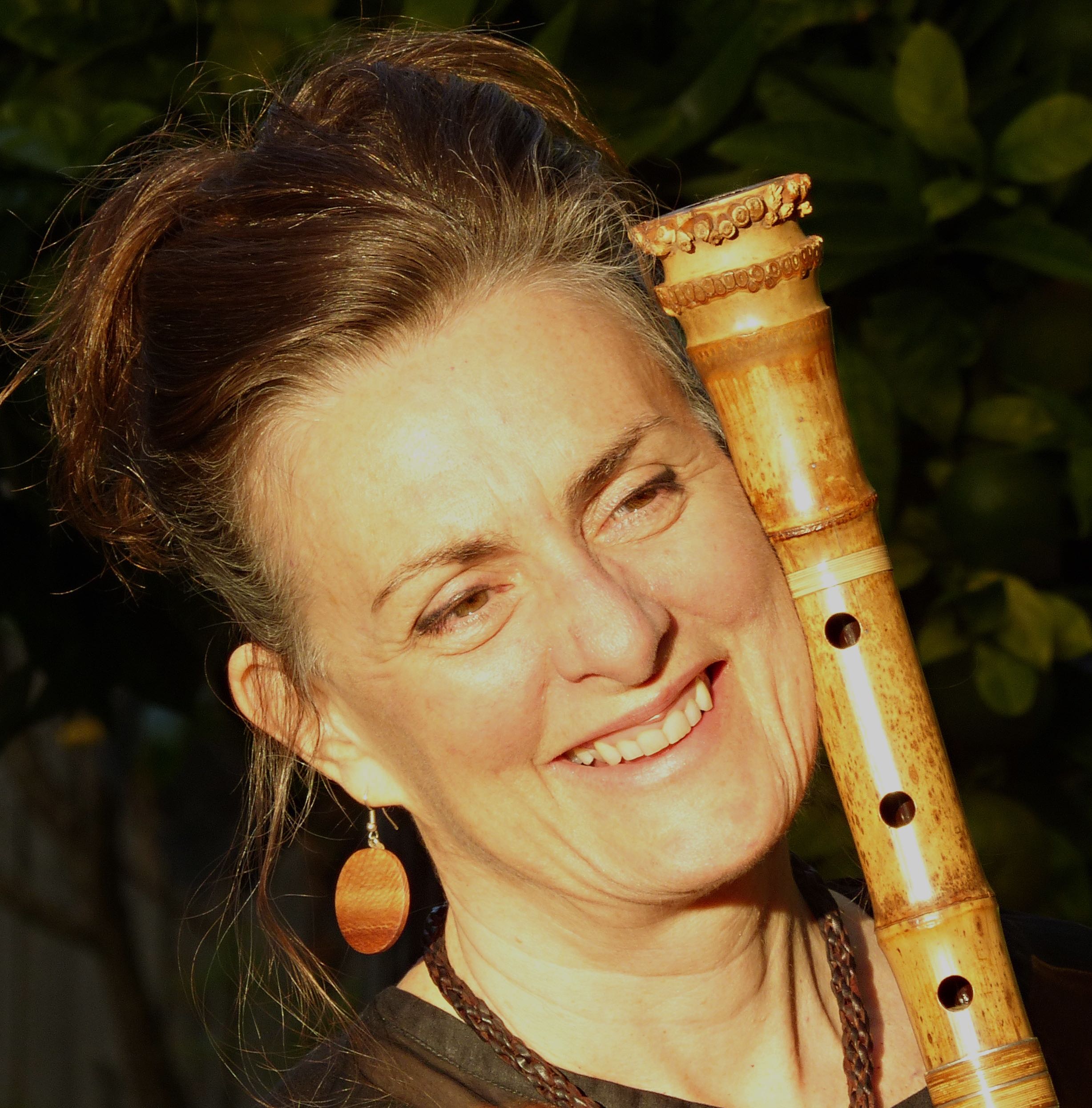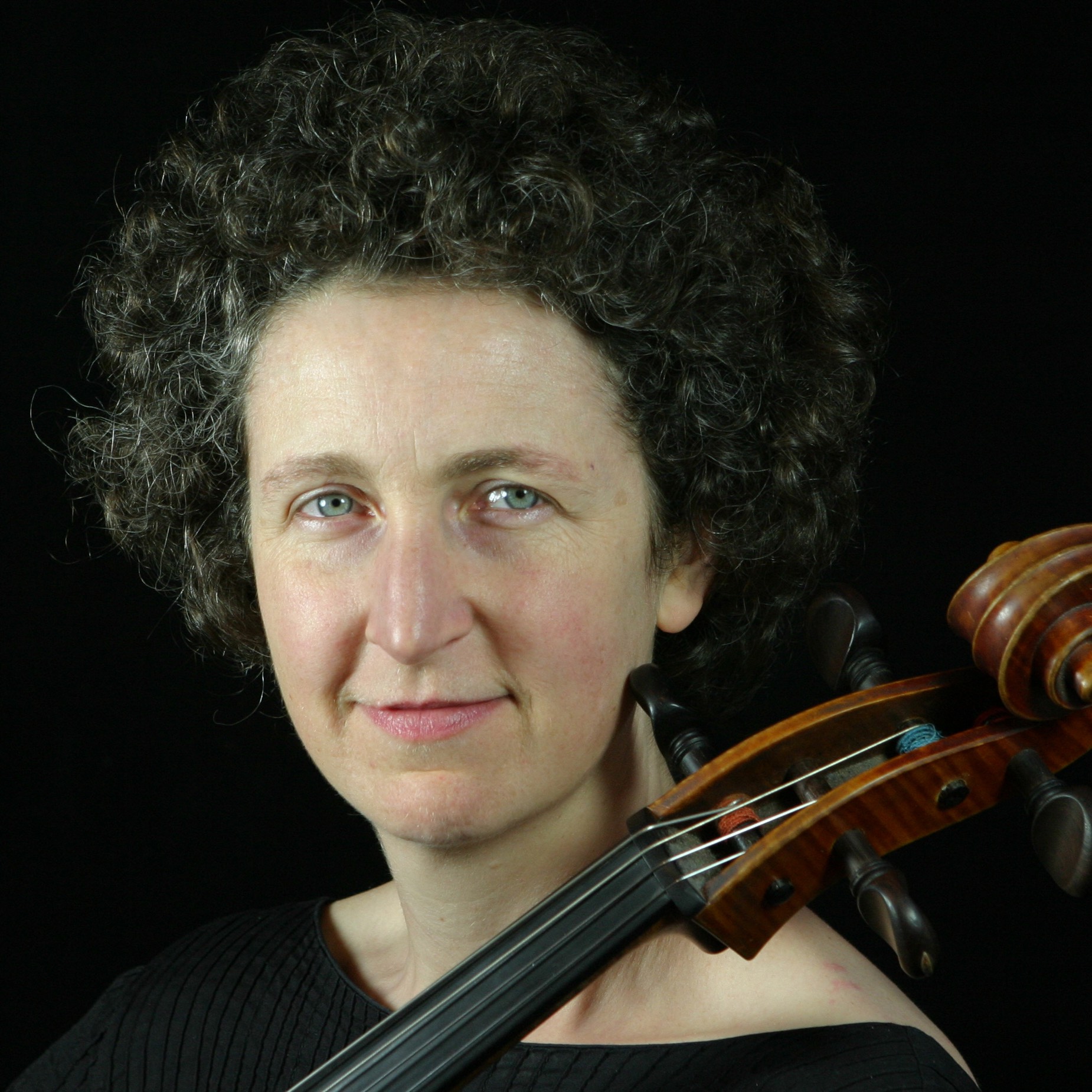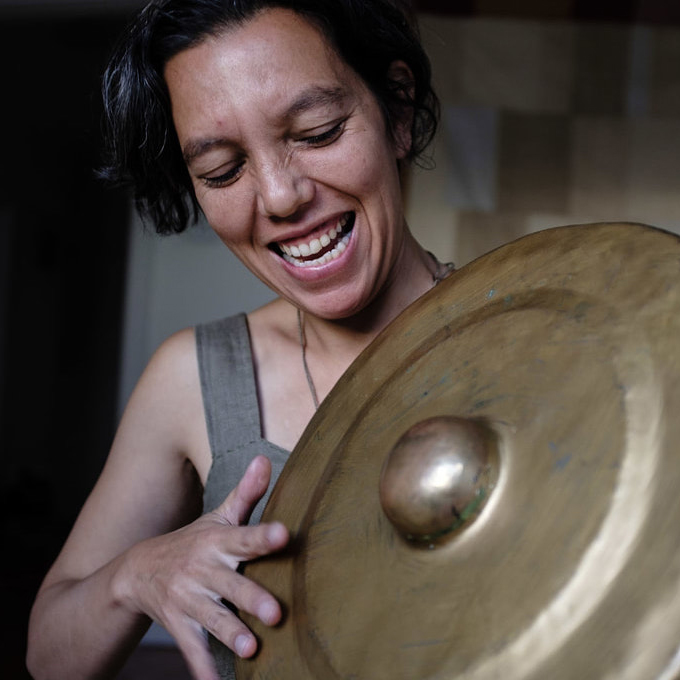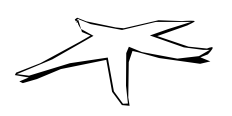Blue on Blue
Box Hill Community Arts Centre, 13th May, 2023
presented by The Boîte
- Anne Norman shakuhachi, stones, composer, AD
- Polyphonic Voices chamber choir lead by Michael Fulcher
- Brandon Lee 13-string koto, 17-string koto
- Mizuno Oyuki 17-string koto
- Stephen Hornby double bass
- Ria Soemardjo vocalist
- Rosanne Hunt cello, glockenspiel
- Sanshi didgeridoo
PROGRAMME NOTES
Far Below Anne Norman 2023
17-string koto, vox/shakuhachi, vocal soloist & choir
Much of the music in this piece is derived from an earlier composition Whispered Shadows, originally a vox/shakuhachi solo. A day spent inside Point Lonsdale lighthouse (including the very top lens encasement) resulted in a poem and the idea for a duo with 17-string koto & recitation. Then, in 2023, this expanded to include new melodic and harmonic material for choir and solo vocalist.
Friendship 友情 Yuujou
didgeridoo solo by Sanshi
Sanshi is playing a didgeridoo crafted by Prof. Inami of Aizu Tanki University in Fukushima. Many Australians gave generous support following the earthquake in NE Japan in 2011, and as a thank you Prof. Inami and his team decorated a termite-hollowed eucalyptus didgeridoo with Japanese urushi lacquer and passed it on to Sanshi. It was also a gesture of moral support for the people of Australia who suffered from the devastating bush fires. As the current caretaker of this beautiful instrument, Sanshi performs it at ceremonies as a symbol of friendship between the people of Japan and Australia. He is taking it to Fukushima and Kumamoto in September this year, when he and Anne are visiting Japan to give a number of concerts.
Heart Moon Trad./ Anne Norman 2022
2.1 shakuhachi & SATB
Shingetsu 心月is a 300 hundred year-old honkyoku (Zen meditation) for solo shakuhachi to which I’ve added four vocal parts, with lyrics inspired by this juxtaposition of ideograms for Heart and Moon. Honkyoku consist of a series of timbral and melodic gestures based on breath arcs in a tradition known as suizen, “blowing Zen.” Heart Moon alternates sections led by shakuhachi breath phrases with metered passages driven by the choir’s lyrics.
Hooded Plovers R.Soemardjo, R.Hunt, A.Norman 2023
cello, voice, liminal stones
At Point Roadknight, after watching the magic of sunrise and waves rolling over rocks, I was thrilled to witness tiny plovers darting across the sand. I later came across pinprick tracks crisscrossing wave-washed sand at Blackrock beach and met volunteers protecting this year’s sole surviving hatchling. This collaboration with Ria & Rosy expresses the magic of sunrise & the fragility of these enchanting endangered birds.
If Stones Could Talk Anne Norman 2023
liminal stones, 13-string koto, cello
I read a beautiful book ‘Written in Stone: Reading the Rocks of the Great Ocean Road’ that introduced me to the many layers of ancient geological history. I realised that stones can tell us stories. Broken off from rock shelves by pounding waves, sandstone plates lie scattered across the Point Roadknight back-beach. Discovering that each has a unique resonant pitch, I gathered a few to experiment with. The patterns and melodies of the string instruments are inspired by the modality of these gathered stones.
I am Ocean Anne Norman 2023
vocalist, choir, 13 & 17-koto, double bass, 2.1 shaku, slide didge, cello
On a beautiful winter’s day with no breaking waves, surfers loll about in the swell staring out to the horizon. Afterwards Jack, a 15 year-old surfer in Anglesea, passionately speaks of his sense of being one with the ocean. Sitting on rocks at Aireys Inlet I counted the intervals between waves, and this became the changing metre of the koto’s lapping waves. Male voices sing the deep ocean swell while female voices paint sunlight dancing on the surface of the bay. Calls of Humpback whales can be heard, and a bass voice intones three Kulin Nation words for Sea and Ocean*. Efforts by indigenous Victorians to revive and share languages of ancestors who were removed from country has my deepest respect.
The vocabulary of the Wadawurrung of the Surf Coast and the Boonwurrung & Bunurong on the other side of Port Philip Bay, where I live, are published in the following sources:
*Warreeny
The Journey Cycles of the Boonwurrung by Carolyn Briggs;
Nywenila: Listen Continuously by Victorian Aboriginal Corporation for Languages.
*Warrain
Kulin Tales by Bunurong author, Sonia Marie.
*Warri
Wadawurrung language app.
Ironbark Gorge Anne Norman 2022
2.0 shaku, 13-koto, 17-koto, double bass, didge, glockenspiel
Ironbark Gorge behind Airey’s inlet and Ironbark Basin between Bells Beach and Point Addis are beautiful places to visit, supporting a great variety of vegetation, reptiles and bird life. Following a walk through Ironbark Gorge, I jotted down melodies that came to me, initiating my first piece for the commissioned surf coast suite. An avid Japanophile, Peter Yates’ only stipulation was that he’d like shakuhachi included in works celebrating the coast he so loves, allowing the emerging melodies to suggest to me koto and later double bass, then didgeridoo. Much later the glockenspiel also entered my imagined ensemble…
Brolga Dawn Anne Norman 2020
choir & field recordings
This choral work was written during lockdown in 2020, after toying with ideas since 2005 when I performed the iconic honkyoku Nesting Cranes 鶴の巣篭 at a concert in Ararat. A farmer in the audience offered to take me to brolga sites, encouraging me to write a piece on Australian cranes. Subsequently more farmers, naturalists and a Gunditjmara elder helped me in my Brolga quest. Over the years I stood in many wetlands at dawn waiting for brolgas to arrive. Then, during further lockdowns in 2020, three friends individually recorded the nine newly-penned wordless vocal parts, funded by a City of Melbourne Quick Response COVID-19 Arts Grant. Michael Fulcher listened to my mix of these tracks and agreed to premier it at the Port Fairy Spring Music Festival in 2021, which became 2022… The magnificent field recordings of brolgas and other wetland birds featured are by Andrew Skeoch of Listening Earth.
Joyful Awakening Sanshi / Anne Norman 2023
D didgeridoo & 2.1 shakuhachi
Walking in the cool morning air along a track that runs parallel to Point Roadknight beach, the bush around me was coming to life with the gently growing light. Then, right in front of me sprang a wallaby. This beautiful creature was the first wallaby I’d seen here. Such joy!
Joyce Stephen Hornby 2020
double bass solo
This piece was written by our bass player, Stephen, during lockdown in 2020. “Wondering what kind of music I’d make if I were stuck alone in a room forever with just my bass, I picked up the bass and wrote 8 bars everyday for two months. I named my bass and this piece after my grandma who passed away soon after. Grandma Joyce took me and my cousins to Anglesea every summer holiday. A magic part of my childhood.”
Blue on Blue Anne Norman 2023
double bass, 17-string koto, cello, SATB, 1.8 shakuhachi, solo vocalist This piece began in Lorne when the blue of sky merged with sea. Driving on to Apollo Bay, blue turned to grey as wind and rain lashed my little car. The lyrics are inspired by the changing weather and a fabulous conversation with retired fisherman Russell Frost in Apollo Bay, followed by a visit to the Maritime Museum to learn about shipwrecks. The names of the 9 survivors from the sinking of SS Casino at Apollo Bay are called out during the storm section of this piece.
The Casino was a hybrid iron steamship augmented with sails, originally rigged as a topsail schooner. Built in Scotland, SS Casino arrived at the Surf Coast in 1882. “Cassie” was a regular part of transportation along the coast between Melbourne and Portland and could carry up to 25 passengers. Fortunately on her last journey there were only two passengers, a woman and a young girl, both of whom survived thanks to the efforts of Stewardess Helena Gill who strapped on their life vests, but did not have time to don one herself. Helena’s name is sung in a rollcall of the 10 crew members who tragically died in the shipwreck.
Cargo ships were always greeted enthusiastically by folk turning up to see what they brought: pianos, books, horses, pigs, chickens, sugar, cases of eggs, butter, beeswax, hair… On July 10, 1932, Cassie approached Apollo Bay in bad weather at 7:30am having sailed through a stormy night from Melbourne. While attempting to dock, a huge wave dumped the ship onto the bottom of the bay, compromising the hull. Within two hours the ship sank and ten people were dead. This loss of life and the destruction of the beloved “Cassie” heralded the end of an era. Four months later, the Great Ocean Road was officially opened at a ceremony in Lorne, and the rhythm of life on the Surf Coast changed forever.
THE ARTISTS
 Anne Norman is a passionate shakuhachi (bamboo flute) performer and composer working in collaboration with a diverse range of musicians and artists. She has performed in festivals across Australia and in Europe, America and Japan and been invited to give workshops on vocalising while blowing shakuhachi in London, Lisbon and Shenzhen. Anne majored on flute at Melbourne Conservatorium before taking up shakuhachi in Kobe with Nakamura Shindo, later with Tajima Tadashi in Osaka, and on scholarship under Living National Treasure Yamaguchi Goro in Tokyo. Knowledge of Western flute repertoire in addition to training in trad Zen, classical and contemporary Japanese genres combined with her studies in ethnomusicology and numerous cross-cultural music collaborations have resulted in her unique approach to music-making. Anne has released many CDs of original music and directed major creative projects including the music-dance theatre production Kagome in Melbourne and Sydney and three seasons of Tunnel Number Five: Festival of Underground Music in the WWII tunnels beneath Darwin. Anne’s various projects have received grants from the Australia Council, Arts Victoria, the Sidney Myer Fund, Japan Foundation & DFAT. Anne also tours nationwide to schools through Nexus Arts presenting storytelling with music. In recent years Anne has increasingly focused on composition.
Anne Norman is a passionate shakuhachi (bamboo flute) performer and composer working in collaboration with a diverse range of musicians and artists. She has performed in festivals across Australia and in Europe, America and Japan and been invited to give workshops on vocalising while blowing shakuhachi in London, Lisbon and Shenzhen. Anne majored on flute at Melbourne Conservatorium before taking up shakuhachi in Kobe with Nakamura Shindo, later with Tajima Tadashi in Osaka, and on scholarship under Living National Treasure Yamaguchi Goro in Tokyo. Knowledge of Western flute repertoire in addition to training in trad Zen, classical and contemporary Japanese genres combined with her studies in ethnomusicology and numerous cross-cultural music collaborations have resulted in her unique approach to music-making. Anne has released many CDs of original music and directed major creative projects including the music-dance theatre production Kagome in Melbourne and Sydney and three seasons of Tunnel Number Five: Festival of Underground Music in the WWII tunnels beneath Darwin. Anne’s various projects have received grants from the Australia Council, Arts Victoria, the Sidney Myer Fund, Japan Foundation & DFAT. Anne also tours nationwide to schools through Nexus Arts presenting storytelling with music. In recent years Anne has increasingly focused on composition.
‘Anne Norman is one of Australia’s most adventurous artists.’
Therese Virtue, Music Sans Frontiers, 3CR radio, 2017.
 Polyphonic Voices is a Melbourne-based chamber choir under the artistic direction of Michael Fulcher. Since its inception in 2013, the choir has become renowned for its polished, innovative and engaging performances of classical choral, jazz, pop and folk music in non-traditional concert venues, often combined with multimedia elements. Their gigs in 2022 included a collaboration with Anne Norman on Brolga Dawn at the Port Fairy Spring Music Festival; the Australian premiere of Eric Whitacre’s The Sacred Veil conducted by the composer at Alexander Theatre, Monash; and Songs For The Earth with Luke Jerram’s majestic Gaia sculpture hanging inside St Paul’s Cathedral. In 2023 they have a full program of concerts including concerts with the Melbourne Chamber Orchestra.
Polyphonic Voices is a Melbourne-based chamber choir under the artistic direction of Michael Fulcher. Since its inception in 2013, the choir has become renowned for its polished, innovative and engaging performances of classical choral, jazz, pop and folk music in non-traditional concert venues, often combined with multimedia elements. Their gigs in 2022 included a collaboration with Anne Norman on Brolga Dawn at the Port Fairy Spring Music Festival; the Australian premiere of Eric Whitacre’s The Sacred Veil conducted by the composer at Alexander Theatre, Monash; and Songs For The Earth with Luke Jerram’s majestic Gaia sculpture hanging inside St Paul’s Cathedral. In 2023 they have a full program of concerts including concerts with the Melbourne Chamber Orchestra.
“…singers who instinctively communicate with one another with a terrifying exactness” Fever Pitch Magazine
 Brandon Lee is a koto performer based in Melbourne. Originally from Malaysia, he was a live-in apprentice under koto virtuoso Kazue Sawai in Tokyo. With a teaching and performance license from the Sawai Koto School and a Masters of Music from Monash University, Brandon actively performs around Australia at events and festivals such as NGV’s Cool Japan, Broome’s Shinju Matsuri and in various collaborations and recitals at the MRC. He has also performed in Japan and America.
Brandon Lee is a koto performer based in Melbourne. Originally from Malaysia, he was a live-in apprentice under koto virtuoso Kazue Sawai in Tokyo. With a teaching and performance license from the Sawai Koto School and a Masters of Music from Monash University, Brandon actively performs around Australia at events and festivals such as NGV’s Cool Japan, Broome’s Shinju Matsuri and in various collaborations and recitals at the MRC. He has also performed in Japan and America.
 Mizuno Oyuki is a koto player and Japanese national resident in Melbourne. She is a member of the Brandon Lee koto ensemble, performing modern and traditional works.
Mizuno Oyuki is a koto player and Japanese national resident in Melbourne. She is a member of the Brandon Lee koto ensemble, performing modern and traditional works.
 Rosanne Hunt enjoys a rich and diverse freelance life, playing cello in music of all periods and many genres with a wide range of colleagues. For Rosanne, 2022 included The Sacred Veil with Eric Whitacre; premiering Elliott Gyger’s award-winning piece for cello and voice Autobiochemistry in Sydney; leading the Orchestra Victoria cellos in the Harlequinade ballet; Australian premieres of Telemann violin works with Elizabeth Wallfisch and the Melbourne Baroque Orchestra (of which Rosanne is a founding member); chamber works for the Australian Ballet’s Bodytorque; and numerous new works with Melbourne’s Forest Collective ensemble. Rosanne also administers the Hunt Family Memorial Fund, helping disadvantaged young musicians to attend the AYO’s annual National Music Camp.
Rosanne Hunt enjoys a rich and diverse freelance life, playing cello in music of all periods and many genres with a wide range of colleagues. For Rosanne, 2022 included The Sacred Veil with Eric Whitacre; premiering Elliott Gyger’s award-winning piece for cello and voice Autobiochemistry in Sydney; leading the Orchestra Victoria cellos in the Harlequinade ballet; Australian premieres of Telemann violin works with Elizabeth Wallfisch and the Melbourne Baroque Orchestra (of which Rosanne is a founding member); chamber works for the Australian Ballet’s Bodytorque; and numerous new works with Melbourne’s Forest Collective ensemble. Rosanne also administers the Hunt Family Memorial Fund, helping disadvantaged young musicians to attend the AYO’s annual National Music Camp.
 Stephen Hornby is a Melbourne based double bass player and composer who has been an active member of the local music scene for over 15 years. Stephen is heavily steeped in the jazz tradition having studied at the VCA with many notable musicians such as Tamara Murthy and Ben Robertson however, possesses a deep love of all music, evident is his diverse musical output and collaborators. Original contemporary music is at the core of his musical practice, composing for and leading/ co-leading several groups including Koi Kingdom and the Faraway Trio as well as lending his bass playing talents to an array of bands and band leaders like Tulalah and Cheryl Durongpisitkul.
Stephen Hornby is a Melbourne based double bass player and composer who has been an active member of the local music scene for over 15 years. Stephen is heavily steeped in the jazz tradition having studied at the VCA with many notable musicians such as Tamara Murthy and Ben Robertson however, possesses a deep love of all music, evident is his diverse musical output and collaborators. Original contemporary music is at the core of his musical practice, composing for and leading/ co-leading several groups including Koi Kingdom and the Faraway Trio as well as lending his bass playing talents to an array of bands and band leaders like Tulalah and Cheryl Durongpisitkul.
 Sanshi is a contemporary didgeridoo player known worldwide for his online didgeridoo dojo. Originally from Shikoku, he is based in Fremantle. He studied yidaki under Djalu Gurruwiwi in Arnhem Land and was given the Yolngu name Malarra (Manta Ray). He performs with artists from modern electro music to classical, world, dance, and with painters and poets. Sanshi has many CDs & tours regularly with Eastwinds through Musica Viva. He has also performed in many venues and festivals across Japan.
Sanshi is a contemporary didgeridoo player known worldwide for his online didgeridoo dojo. Originally from Shikoku, he is based in Fremantle. He studied yidaki under Djalu Gurruwiwi in Arnhem Land and was given the Yolngu name Malarra (Manta Ray). He performs with artists from modern electro music to classical, world, dance, and with painters and poets. Sanshi has many CDs & tours regularly with Eastwinds through Musica Viva. He has also performed in many venues and festivals across Japan.
 Ria Soemardjo is a Melbourne based musician with a passion for collaborating with artists across a diverse range of genres and art forms. Her distinct, haunting vocal style reflects her Australian/Indonesian cultural heritage and she draws on her fascination for Indonesian musical traditions in her song writing and collaborative projects. Ria incorporates improvisation into her music performances and in theatre pieces. She has released two albums with Fine Blue Thread – a trio with melodic multi-tabla (Sam Evans) and cello (Helen Mountford).
Ria Soemardjo is a Melbourne based musician with a passion for collaborating with artists across a diverse range of genres and art forms. Her distinct, haunting vocal style reflects her Australian/Indonesian cultural heritage and she draws on her fascination for Indonesian musical traditions in her song writing and collaborative projects. Ria incorporates improvisation into her music performances and in theatre pieces. She has released two albums with Fine Blue Thread – a trio with melodic multi-tabla (Sam Evans) and cello (Helen Mountford).
Blue on Blue is a joyous immersion in country, a walk through woodland, a wander along wind-swept beaches and a plunge into the ocean’s powerful swell. It conveys stories of the coast from the passion of a teenage surfer to the tales of a retired fisherman, and the tragedy of shipwreck.
I am extremely grateful to the Peter and Susan Yates Foundation, and to Peter’s associates from the Salzer and Trawalla Foundations, for graciously funding the composition, rehearsal and recording of music to celebrate Victoria’s coast from Point Lonsdale to Apollo Bay. The project is auspised by the Boite and made possible by the generosity of those who housed me in my search for composition inspiration. Anne
Shakuhachi is an end-blown bamboo flute constructed from various lengths of the root-end of a heavy species of bamboo. Used for centuries in Japan as a monk’s tool for “Blowing-Zen,” these meditations were known as honkyoku (original pieces). Some honkyoku were used as a form of prayer while others were contemplations on the power and fragility of the environments through which these itinerant monks wandered. Shakuhachi was also played to accompany folk songs and perform chamber music with plucked strings. Shakuhachi is now played globally in evocative film music, mixed music ensembles of various genres, as well as for personal contemplative expression.
Koto is a zither introduced to Japan from China in the 7th and 8th century. Originally it was used in court music (Gagaku), becoming accessible to other forms of chamber music and solo performance through the compositions and teachings of koto virtuoso Yatsuhashi Kengyo in the 17th Century. Until the early 20th century, koto had 13 strings made from silk. Then another composer and koto virtuoso, Miyagi Michio, invented the 17-string bass koto, seeking a deeper sound for his compositions. Both instruments are now strung with nylon strings and are used extensively in many genres of music.
The Boîte is Victoria’s iconic multicultural music organisation, creating opportunities for culturally diverse music to contribute to a richer, more inclusive Australia.
The Boîte acknowledges the tribes of the Kulin Nation, the Traditional Custodians of the land upon which we reside. We pay our respects to Elders from all nations – past and present.
